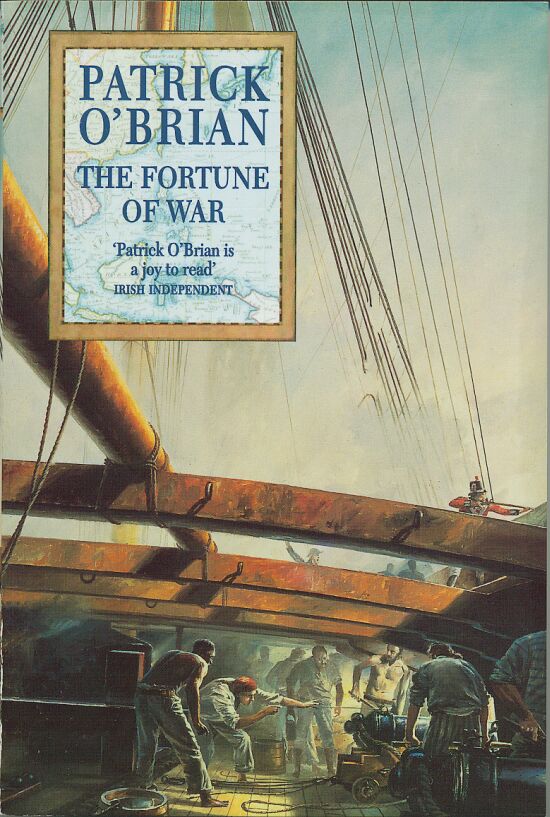O'Brian, Patrick (1979) The Fortune of War New York: Norton.

Opening Line: The warm monsoon blew gently from the east, wafting HMS Leopard into the bay of Pulo Batang."
When I was little, my Dad loved to take me and my two brothers sailing. The wind and waves and the push of the wind along with time with our dad, made it usually a wonderful experience. Even when the wind would die down and we would be stuck off shore waiting for the slightest breeze, it was a fun thing to do. I suppose there were moments during those sailing jaunts, when I must have imagined what it would have been like to be on a three-masted navy frigate during the War of 1812, with cannon fire and smoke and what it would have been like to have been on such a ship when the entire battle could turn on how well each vessel was captained. If i didn't imagine such a thing, I should have.
Patrick O'Brian's series featuring Captain Jack Aubrey was not written for young adults, but those that are interested in sailing, naval battles, intrigue, and occasional moments of humor, might enjoy this series. I am sure it is best o read them in order, but I have never done so. I buy one of the series int he bookstore every now and then. I don't worry about where in the series I am or how far Captain Aubrey has risen in the ranks. Instead I just settle down and enjoy the story as it takes me aboard a wooden vessel and into a wonderful world of strategy and sailing.
This particular book takes Captain Aubrey and his good friend, Naval Surgeon (and secret agent) Stephen Maturin into the war of 1812 and all the battles, politics, and intrigue that you would expect. Frankly, though, it doesn't really matter which book you grab. They are all quite wonderful. This, however, would not be a good book for a new reader. The print is small, the vocabulary advanced, and the voice takes some getting used to before you begin to recognize the funny bits. For the right student, though, this series could keep them busy for quite a while.
Shiga, Jason (2011) Empire State: A Love Story (Or Not) New York: Abrams ComicArts.

Opening Lines: "See ya tomorrow, Jimmy. / Bye. / Hey, come with me to Longs. I wanna grab a pack of smokes."
There is a genre of graphic novels that exists somewhere between memoir and realism, that consists of a portrayal of the everyday lives of everyday people. It tends to be sort of low energy and a little cynical and a little on the edgy side. Empire State fits into this category. It is the story of Jimmy, an Asian-American 20-something who works in a library and lives with his mom. Sara, his friend, moves to New York and Jimmy decides to follow her and confess his love for her. Unfortunately, his plans go awry and he never is quite able to tell her how he feels. And that is pretty much how it ends.
For most of your students, this would be a depressing and perhaps pointless graphic novel to read. It certainly will not be the most popular book in your classroom library. But there are always some students who want a story that rings true to their experience in the world. Punk rock, Catcher in the Rye, Who's Afraid of Virginia Woolf, black and white photography of poverty and destitution: all these things appeal to kids who want to see their world mirrored in the art they consume. Things don't always seem to work out. Not every princess meets a prince. Job offers don't always work out. And sometimes coincidences work against us as well as for us.
The art mirrors these themes. Shiga's main characters seem permanently slouched and pudgy. The settings are typical and relatively uninteresting. At one point, Jimmy goes to the observation deck at the Empire State building, hoping to meet Sara there. Shiga draws the deck in a way that makes it seem more like a fenced in schoolyard than a place to see the city. This is not a world of amazing vistas or unequaled metropolises, or redemptive love. It is a world of the utterly ordinary and unremarkable.
Empire State is a graphic novels that will make that connection for that sort of student. There is despair, banality, vulgar language, futility, mediocrity, and maybe some of the truth that student is looking for. This is certainly not a graphic nvoel for everyone, but for some students, it might help them to know that they are not alone in how they see the world. Because of the language, it might be best to keep this one behind your desk and only loan it out to students who will be neither surprised nor offended.




